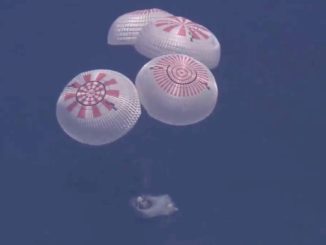
An Indian software developer and mechanical engineer combing through high-resolution imagery captured by a NASA spacecraft has located debris scattered on the lunar surface in September by the crash of the Vikram lander, India’s first probe to attempt a soft touchdown on the moon, NASA said Monday.
A camera mounted on NASA’s Lunar Reconnaissance Orbiter has recorded images of the Vikram spacecraft’s target landing site since Indian ground controllers lost contact with probe Sept. 6 during final descent to the moon.
The robotic Vikram lander was descending toward a landing zone around 373 miles (600 kilometers) from the moon’s south pole. With Vikram, India aimed to become the fourth country to achieve a soft landing on the moon.
But engineers at the Indian Space Research Organization’s mission control center lost communication with Vikram moments before landing, when the probe was just 1.3 miles (2.1 kilometers) above the lunar surface.
The festive mood in the control center in Bengaluru quickly turned somber. Indian prime minister Narendra Modi, who was at mission control to observe the landing, consoled ISRO chairman K. Sivan and other members Vikram team.
Vikram was named for the father of India’s space program. The lander departed Earth in July with India’s Chandrayaan 2 spacecraft, a three-piece lunar explorer comprising an orbiter, lander and rover.
The Vikram lander — with the Pragyan rover on-board — detached from the Chandrayaan 2 orbiter before starting its descent. The orbiter remains operational with its own set of scientific instruments, including sensors to map the lunar surface and search for evidence of water ice hidden in dark polar craters.
After Vikram stopped communicating with ground teams, ISRO began looking for signs of the lander with the sharp-eyed camera on the country’s new Chandrayaan 2 orbiter. Within days, the Indian space agency announced the orbiter had located the lander on the moon, and added that engineers continued to attempt to contact it.
Chandrayaan 2’s camera can resolve more detail on the lunar surface than the imager aboard NASA’s LRO spacecraft, but ISRO has never released any images from the Chandrayaan 2 orbiter showing the Vikram crash site.
Instead, LRO went to work searching for Vikram’s wreckage and imaged the landing site Sept. 17. And thanks to NASA’s open data policy, the U.S. space agency published imagery from each of LRO’s passes over the Vikram landing site. The public responded by sifting through the pictures, comparing images taken before and after the Sept. 6 crash to identify any changes that might hint at Vikram’s location.
Shanmuga Subramanian, an Indian programmer who lives in Chennai, tipped off NASA when he noticed a new dot in an image from the LRO’s mapping camera.
In an email sent to Spaceflight Now, Subramanian wrote he searched NASA’s images of the Vikram landing site in his spare time.
“It was something challenging as even NASA couldn’t find out, so why (not) try it out,” Subramanian wrote. “And that’s the thought that led me to search for Vikram … I don’t think Vikram lander would have made such an impact on (the) minds of (the) Indian public if it had landed successfully. Since it was lost, there was (a) lot of discussion in public forms as well as on my Facebook regarding what malfunctioned, etc.”
He said the Vikram lander’s crash got him hooked. He searched through NASA imagery every night for four or five days.

Subramanian, who said he’s been interested in space exploration since childhood, deduced the Vikram lander’s flight path before landing from information gleaned from social media.
“I searched around north of the landing spot as Vikram approached the landing spot only from (the) north,” he wrote. “And though there were lot of false positives, I found a tiny little dot and compared with previous LRO images (over the) last nine years, which eventually confirmed it would be the debris. Then I reached out (to) NASA.”
NASA said it confirmed Subramanian’s discovery by comparing before and after images of the Vikram landing area.
“When the images for the first mosaic were acquired, the impact point was poorly illuminated and thus not easily identifiable,” members of the Lunar Reconnaissance Orbiter Camera, or LROC, team wrote in a statement. “Two subsequent image sequences were acquired on Oct. 14 and 15, and Nov. 11. The LROC team scoured the surrounding area in these new mosaics and found the impact site (70.8810°S, 22.7840°E, 834 m elevation) and associated debris field.”
Subramanian received an email from NASA Monday thanking and congratulating him for his role in determining Vikram’s final resting place.
@NASA has credited me for finding Vikram Lander on Moon’s surface#VikramLander #Chandrayaan2@timesofindia @TimesNow @NDTV pic.twitter.com/2LLWq5UFq9
— Shan (@Ramanean) December 2, 2019
Subramanian suggested the public could contribute more to space missions in the future. One example way students and others might help is by building a database to help with before-and-after image comparisons, a process which Subramanian performed manually.
He added that he hopes his discovery will inspire others.
“It clearly proves someone who is not involved in space exploration or a scientist can also do a lot as far as space is concerned,” Subramanian wrote.

Indian space officials have not announced the exact cause of Vikram’s crash landing on the moon. The Indian government only officially acknowledged that the lander crashed in November, more than two months after the loss of Vikram.
In a written response to questions from a member of India’s parliament, Jitendra Singh, the Indian government official responsible for the country’s space program, offered new details about Vikram’s failed landing.
He wrote that Vikram performed as expected during the first phase of its descent from an altitude of 30 kilometers (98,400 feet) to 7.4 kilometers (24,300 feet) above the moon’s surface. During that time, the spacecraft’s velocity was reduced from 1,683 meters per second (3,764 mph) to 146 meters per second (326 mph).
“During the second phase of descent, the reduction in velocity was more than the designed value,” he wrote. “Due to this deviation, the initial conditions at the start of the fine braking phase were beyond the designed parameters. As a result, Vikram hard landed within 500 m (meters) of the designated landing site.”
He added that most of the Chandrayaan 2’s technology demonstration objectives were successfully accomplished, including the launch, critical orbital maneuvers, lander separation, de-boost and the “rough braking phase” of the descent.
The Chandrayaan 2 orbiter is expected to function at least seven years.
“With regards to the scientific objectives, all the eight state-of-the-art scientific instruments of the orbit are performing as per the design and providing valuable scientific data,” Singh wrote.
Email the author.
Follow Stephen Clark on Twitter: @StephenClark1.



